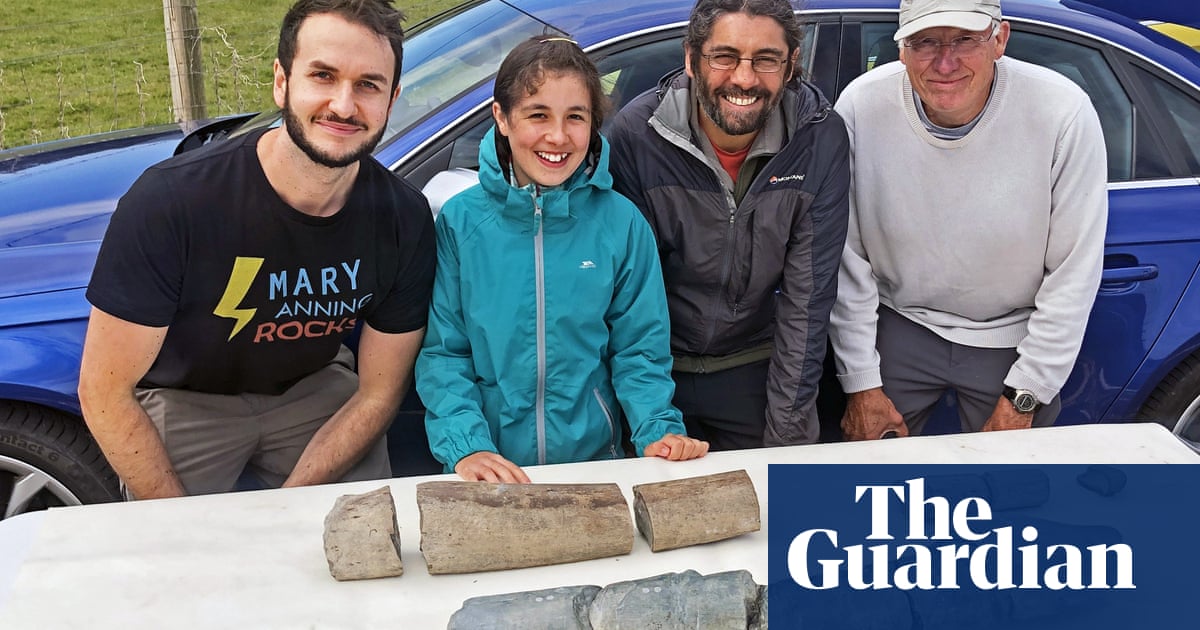A 11-year-old girl, Ruby Reynolds, alongside her father, Justin Reynolds discovered a massive jawbone on a beach in Somerset, England, back in May 2020. The first pieces of the jawbone were identified as belonging to a previously unknown species of ichthyosaur, a prehistoric sea reptile.

Also Read: Ancient Tomb Unveils the Secrets of Panama’s Coclé Civilization
The newfound species named Ichthyotitan severnensis, is believed to be the largest sea reptile ever to have lived rivaling the size of the modern blue whale.
Estimates suggest that this giant sea reptile measured over 82 feet (25 meters) in length equivalent to the size of two city buses.
Ruby and Justin Reynolds’ discovery made collaboration with paleontologist Dr. Dean Lomax from the University of Bristol and fossil collector Paul de la Salle.
Together they went on a search for additional fragments of the jawbone, leading to the identification and reassembly of the specimen.
The findings detailed in a report published in the journal PLOS One showed the history and ecological role of these ancient marine giants.
The study show that Ichthyotitan severnensis lived approximately 202 million years ago during the Triassic period coexisting with dinosaurs.
Analysis of the fossilized bones suggests that Ichthyotitan severnensis was still growing at the time of its death, showing the potential for even larger sizes in adulthood.
Histological examination revealed ongoing growth patterns hinting at the creature’s size and biological adaptations.
The discovery also provides information into the extinction of these giant sea reptiles, believed to have occurred during a mass extinction event at the end of the Triassic period.
Following this event, surviving ichthyosaurs did not attain the colossal sizes observed in Ichthyotitan severnensis.
The fossil specimen soon to be displayed at the Bristol Museum and Art Gallery addressing the importance of amateur fossil collectors in scientific discoveries.
Ruby Reynolds now 15 years old has been credited as a co-author of the research paper, making her contribution to paleontological science.
Scientists say that the need for further research to confirm the exact size and characteristics of Ichthyotitan severnensis.
Also Read: World’s Oldest Fossilized Forest Dating Back 390 Million Years Discovered in UK
The hope remains that additional fossils, such as a complete skull or skeleton, may be unearthed in the future providing deeper insights into these ancient sea reptiles.
The discovery addresses efforts of early paleontologists like Mary Anning, who unearthed the first known ichthyosaur fossils in the early 19th century. Since then, over 100 species of ichthyosaurs have been identified worldwide.
They contacted Dr. Dean Lomax, a paleontologist at the University of Bristol, who joined forces with them to further investigate.
The fossilized jawbone identified as the surangular measured over 6.5 feet (2 meters) in length, hinting at the massive size of the creature.
Through excavation and collaboration with other experts including fossil collector Paul de la Salle the team pieced together additional fragments completing the jawbone puzzle by October 2022.
The discovery of Ichthyotitan severnensis gives insights into the history of sea reptiles and their role in ancient ocean ecosystems.
Researchers suggest that this giant sea reptile, estimated to be over 82 feet (25 meters) long, may have rivaled the size of the modern blue whale challenging previous notions of the largest known animal.
Dr. Dean Lomax, lead author of the study, highlights the importance of the find addressing the collaborative effort between amateur fossil collectors and scientists.
Dr. Nick Fraser from National Museums Scotland acknowledges the importance of the fossil while expressing cautious optimism about assigning it as a new species due to its incompleteness.
Since the first ichthyosaur fossils were unearthed in the 19th century, over 100 species have been identified worldwide contributing to our understanding of prehistoric life.
Ruby Reynolds’ involvement in the scientific process from discovery to co-authorship of the research paper exemplifies the nature of paleontology, welcoming contributions from individuals of all ages and backgrounds.
Also Read: Europe’s Largest Mass Grave With 1000 Skeletons Discovered in Germany
























